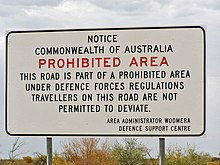Spinifex People
The Spinifex People (also Pila Ngura ) are an Aboriginal tribe that lives in the Great Victoria Desert (424,400 km²) and on the Nullarbor Plain (approx. 200,000 km²) in Australia . The tribe first had contact with whites in the 1950s when the joint nuclear weapons tests (1950–1963) by the British and Australian governments began with the Maralinga project on the so-called Emu field. The discovery was a sensation at the time.
The Aborigines are named after the spinifex grass , a genus of prickly sweet grass , three of which are common in the region. In the Aboriginal language, Pila Ngura means "home between sand hills".
discovery

In the course of the preparation of a series of British nuclear weapons tests with bombs in the order of magnitude of up to 25 kilotons of explosive force, the government commissioned the bush expert Walter Macdougall (1907-1976) to search for people in the Victoria Desert region with just one assistant warn them and remove them from the danger area. It was found that this was the occasion when the Spinifex People saw white people for the first time. The last white people crossed this area in the 1910s and 1930s, respectively. The government issued a ban on staying within 200 kilometers of the detonation site and detonated the first atomic bomb on October 15, 1953. Removing all people in this vast area of the outback was a difficult task for two people, which was also made more difficult that the Spinifex People couldn't read the signs that were put up. Due to the Aboriginal fear of airplanes and flying, the resettlement was probably only partial and some of the people stayed in the endangered area, the Woomera Prohibited Area . This area was from 1947 to 1982 a restricted area in the Australian state of South Australia with an area of 127,000 km², which included the city of Woomera . The Australian and British governments organized and paid for two decontamination programs. However, some areas are still contaminated today; a warning is given before a passage.
expropriation
As part of the atomic bomb tests, the Spinifex People were expropriated by the Australian government. Over 200 people were displaced from their homes between 1955 and 1963 and resettled in a mission settlement in Cundeelee and Warburton 200 kilometers east of Kalgoorlie . In the early 1980s, the Cundeelee mission was closed and the Aborigines were relocated to other areas. The Spinifex people successfully sued the High Court of Australia, the highest court in Australia, for the return of their homeland, which they were awarded on November 28, 2000. The area they got back is 54,315 square kilometers. The rights to mineral and oil extraction are excluded. Furthermore, the water usage rights are restricted. They settled back in Tjuntjuntjara, in their original homeland.
Art and dream time
The Spinifex People founded a Spinifex Arts Project in Tjuntjuntjare . Painting is an essential part of their life and their self-image. The works of the art project are exclusively works for their own purposes and their dream time . Her dream time and her pictures are not just a myth, “but a code of conduct that encompasses the entire social and individual life. It contains rules of conduct in the event of disasters such as floods and fires or for caring for the environment ” . The art project first exhibited outside Australia in London in 2005 and in Broome , Western Australia in August 2007 .
See also
literature
- Scott Cane: Pila Nguru. The Spinifex People . Printing Press, Fremantle 2002, ISBN 1-86368-348-8 .
- Gerhard Leitner: The Aborigines of Australia . Beck-Verlag, Munich 2006, ISBN 3406508898 .
Web links
- Website of the Spinifex People (English)
- Images selection of Spinifex People (English)
- Legal title to the land (English)
- Videos of the nuclear test
- Comment of the nuclear engineer Alan Parkinson on the decontamination (English)
Individual evidence
- ↑ Leitner: Die Aborigines, p. 37f (see literature)
